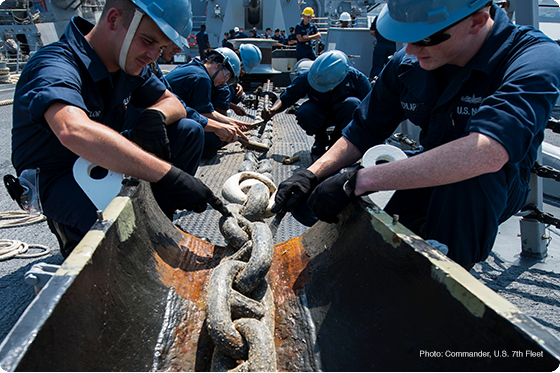
In June 2017, the Puget Soundkeeper Alliance, the Washington Environmental Council, and the Suquamish Native American tribe filed a lawsuit against the U.S. Navy in the U.S. District Court for the Western District of Washington alleging that its ship cleaning activity violated the federal Clean Water Act (CWA) and Resource Conservation and Recovery Act (RCRA). Specifically, the plaintiffs’ lawsuit seeks to hold the Navy accountable for having scraped some 730 cubic yards of solid materials from the hull of the decommissioned aircraft carrier U.S.S. Independence into Washington’s Sinclair Inlet in 2016. In May 2019, the State of Washington’s Attorney General’s Office decided to intervene in the lawsuit, thereby making it the state’s biggest environment-oriented legal action against the Navy’s Puget Sound Naval Shipyard (PSNS).
The Navy’s ship cleaning activity at issue originated because of one thing—barnacles. Though often mistaken for shellfish, barnacles are actually crustaceans that adhere to surfaces in areas of high activity, such as underwater volcanos and intertidal zones, where they reside on sturdy objects like rocks, pilings, and buoys. Moving objects such as boat and ship hulls are also vulnerable to barnacle colonization, where they can cause drag issues, leading to significant economic and environmental costs. The U.S. Navy estimates that heavy barnacle growth on ships increases weight and drag by as much as 60%, resulting in as much as a 40% increase in fuel consumption. This translates to an approximate $1 billion in extra fuel costs per year as well as a significant increase in carbon emissions from the Navy. As a result, the Navy has utilized tools such as “anti-fouling” paint in the past—which is meant to slow the growth and facilitate the detachment of any barnacles that may attach to a ship’s hull. While the creation of steel hulls has largely eliminated the use of such copper-laced paint, older ships can still carry the substance. This was the case with the decommissioned U.S.S. Independence, which docked in the Puget Sound Naval Shipyard to have its hull scraped prior to being sent to Texas to be torn apart for scrap.
According to the lawsuit’s plaintiffs, the Navy’s hull scraping activity on the U.S.S. Independence released an unknown amount of copper-laced paint chips into Sinclair Inlet, where they quickly sunk to the bottom, eventually raising the concentration of copper in the surrounding waters to impermissible levels as per the CWA. Furthermore, the lawsuit alleges that the Navy failed to obtain a CWA pollution discharge permit for its release, and also violated RCRA by creating an “imminent and substantial endangerment” to the environment. This environmental harm is what brought the Suquamish tribe into the lawsuit. According to the tribe, the Navy’s addition of copper to the waters of Sinclair Inlet could adversely affect the Chinook salmon, coho, and chum present there, thereby diminishing the fishing rights that were originally reserved for the tribe by the federal government in 1855 when the Treaty of Point Elliott was signed.
Washington’s Attorney General, Bob Ferguson, added to the original plaintiffs’ allegations when he joined the lawsuit earlier this year. Ferguson sent a letter to the Navy in January advising the military branch that he would join the lawsuit if it did not resolve the copper pollution issue within 60 days. When the Navy failed to do so, Ferguson filed a motion to intervene, asserting that the Navy violated the state Water Pollution Control Act in addition to the federal statutes originally at issue. In a statement, Ferguson contended that while the Navy has a duty to protect the nation’s waters, its actions endanger Washington’s diverse marine life, including salmon and orcas. In his office’s opinion, the Navy should take responsibility for such actions and be held legally accountable.
The plaintiffs are asking the court to order the Navy to clean up the current contamination it allegedly caused in Puget Sound, and to stop cleaning vessels in way that releases toxic metals and other hazardous materials into the environment. To the latter point, a victory for the plaintiffs would mean that the Navy would be prevented from cleaning another decommissioned aircraft carrier, the U.S.S. Kitty Hawk, in the same way as it did the U.S.S. Independence. What alternative hull cleaning methodology the Navy would then turn to remains to be seen, although the Environmental Protection Agency has recommended in the past that the military branch clean ships in drydock so as to prevent the release of materials directly into the aquatic environment. Whatever the case, as the Navy only has three inactive ship maintenance facilities in the United States (with the other locations being in Philadelphia and Pearl Harbor), PSNS can expect to receive a steady stream of decommissioned ships at its facility for years to come.












